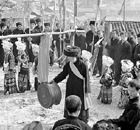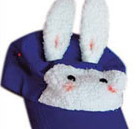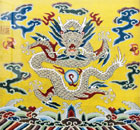Delicacies
Tarts from the heart
By Pauline D Loh (China Daily)
Updated: 2011-02-08 07:36
 |
Large Medium Small |
|
Pineapple tarts were part of the baked delights offered to visitors who came during the Lunar New Year. Photos by Pauline D Loh / For China Daily |
Straits Chinese cooks were the firstfusion chefs. Pauline D Loh recalls childhood treats of home.
Beijing
All through the spring period that marked the beginning of the lunar year, all sorts of delicious smells would waft from my grandmother's kitchen. She was a classic Straits Chinese nonya, a lady of leisure who left everyday cooking to her army of domestics but took pride in producing delicate baked goods when the occasion arises.
The one treat she always made for the New Year was pineapple tarts, buttery containers of which were rationed throughout the two-week period of festivities.
The first sign we got that it was tart-baking time would be the wicker basket full of ripe pineapples my grandfather would send back from the Chinatown market. For the next two days, my grandmother would plot out the war plan. Her older daughters and two servants would be delegated to peel the fruit in our courtyard.
Although they would be suitably ripe, the pineapples were still acidic enough to erode the knives into scythe-shaped scalpels, an indication of how long the tart-making tradition had been kept.
After the peeling came the grating, and the women would don rubber gloves and set to work. Huge tubs of grated pineapple were drained over bamboo colanders, and the juice collected and sweetened, then chilled in my grandmother's pride and joy, the Kelvinator refrigerator. When thirsty visitors came, there would be a plentiful supply of fresh pineapple juice with ice-cubes clinking in the glass.
The drained pineapple pulp would then go into grandma's huge enamel jam pot for a long, slow cooking with sugar. Cinnamon, cloves and star anise would be added to create that heady perfume of hot sugar, pineapple and spices. It permeated the house, and stopped the grandchildren in our play as we raised our heads and sniffed like hungry puppies.
After the jam was set enough to satisfy grandma's exacting standards, it was set aside to cool while the pastry making got underway.
My grandpa would have been sent shopping again, and had already returned with a huge bag of Canadian wheat flour and blocks of cold butter.
Grandma would take control and set up workstations in the kitchen this time. One pair of girls would sift the flour, holding the wooden sift at an exact height over the mixing bowls because grandma said that was the best way to get a light pastry. Every time a mixing bowl was three-quarters full, it got passed to the next station, where the frozen butter would be grated into the flour, and quickly mixed with light fingers to form a crumb-like mix.
Grandma took over the last stage, trusting no one else to add just enough egg to bring the mixture together into dough.
At this stage, another workstation across the kitchen would be rolling the jam into little balls, ready to be made into her famous pineapple tarts. They would slowly pile up in a huge cooled metal mixing bowl, like tiny exotic bird's eggs.
By now, some mysterious signal would have gone out to the kids and we would start gathering at the kitchen doorway, where we were allowed no further.
From our vantage view on the steps, we would watch mesmerized as Grandma's deft fingers shaped miniature pineapples out of the dough and filling. With a few snips of her embroidery scissors, she would create tiny, spiny fruit and top them all with a clove stuck into the top for a stem.
The first tray of tarts would go into the oven, and again, we would snuffle the air, taking in the delicious buttery aroma as the tarts baked, on tip-toes in anticipation for when the tarts came out again.
My grandma loved us. She would sternly tell us to line up, and reward obedience with a piping hot pineapple tart that we would cradle in our palms and scuttle off to a private corner to savor and enjoy.
And all though the festivities, we would be eating tarts from the tins, enjoying the salty sweetness of the little perfect confections that so symbolized Lunar New Year for us.
I was the only grandchild fortunate enough to learn how to make these tarts from my then ailing grandma. I will never be half as good as she was, at least not for another 10 or 20 years, but my memory of these tarts are so warm and comforting that I want to share them with you.
We all need the rooms of delicious recollection to retreat to when life gets tough.
Recipe | Pineapple tarts
Ingredients (makes abt 50):
250g butter, frozen
400g flour
1 egg plus
1 egg yolk, beaten
1 tsp baking powder
1 tsp salt Pineapple jam
Cloves
1 egg beaten, for eggwash
Method:
1. Mix plain flour with salt and baking powder. Sieve twice and chill. Grate butter into chilled flour.
2. Quickly mix and rub lightly with cool fingers to form crumbs. Add beaten eggs and just a dash of icy water to get a soft dough.
3. Divide dough into two batches and chill any that you are not working with on the board.
4. Pinch chestnut-sized pieces of filling and roll into balls. Roll out pieces of chilled dough and place pineapple filling in centre. Shape into balls.
5. Stick a clove on top to form a stem. Brush with egg wash and bake 8 to 10 minutes
until golden brown. Cool and store in air-tight containers.
Foodnotes:
You can snip little patterns on the covered balls to make them look like pineapples. But cut too deep and they look more like hedgehogs. I made plenty of hedgehogs in my time, so now, my tarts are unsnipped. An easy method is to use small flower-shaped biscuit cutters. Press a ball of filling into the center and lightly brush with eggwash.
Recipe | Pineapple jam
Ingredients:
2 kg pineapples, peeled
1 kg sugar
2 star anise pods
3-4 cloves
1 stick cinnamon
Method:
1. Weigh the pineapples after you have skinned them to get 2 kg of fruit. Grate coarsely and then place them on a colander to drain. Keep and chill the juices for a refreshing drink.
2. Place drained grated pineapple in a large, thick-bottomed pan together with the sugar and the spices. Cook over medium fire, stirring often.
3. When the jam has turned a golden brown and is forming a large ball in the pan, it is ready. Pick out all the spices and let cool.
Foodnotes:
Jam making is always tedious but the rewards are immeasurable. One of the scents from the kitchen that always remind me of the Lunar New Year was the smell of pineapple jam gently cooking on the stove, conjuring memories of my grandmother.
(China Daily 02/08/2011 page9)











